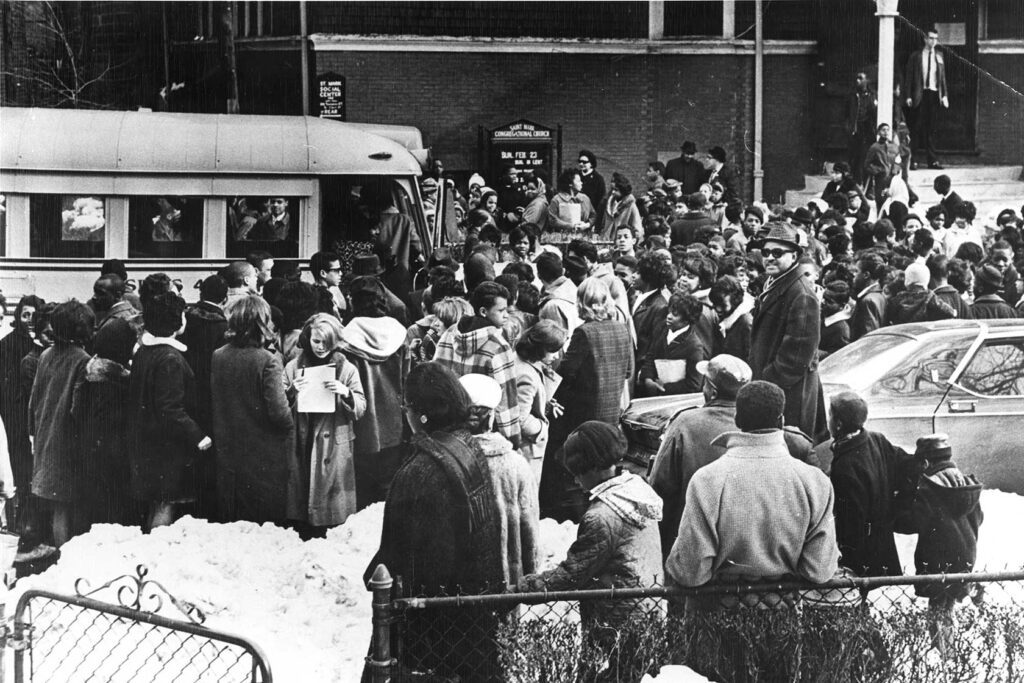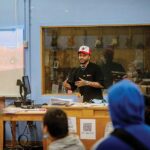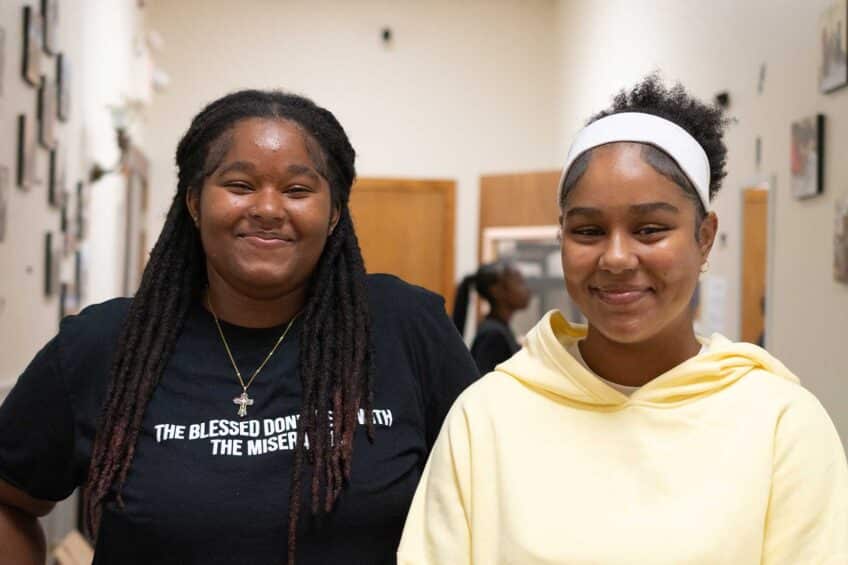‘This is our Selma. This is our Little Rock.’
Walking tour illuminates Boston’s desegregation history 50 years after busing

On June 21, 1974, Judge W. Arthur Garrity ruled segregation in Boston’s schools unconstitutional, ordering the busing of students between majority Black and white neighborhoods, which began three months later on Sept. 12.
Fifty years to the day busing first started, on a sunny Thursday, professor and minister Charlie Glenn walked through the streets of downtown Boston, reminiscing on the moments leading up to one of the most fraught periods in Boston’s history.
Pinned to his chest were two circular buttons from the past that he’d held onto for years. One of the buttons depicted two children — one Black, the other white — sitting on a school bus. “Keep the buses rolling,” the button read, a motto that emerged in the face of mounting opposition to busing. The other button called for “Better Schools” and “Integrated Schools.”
What Black organizers and parents experienced during the movement to desegregate schools “was a lack of respect,” Glenn said. “It was a sense that Black citizens of Boston really didn’t count.”
Glenn, a community organizer, had been involved with the Freedom Stay-Outs in 1963 and 1964 during which students across the city boycotted their regular schools and instead attended so-called Freedom Schools where they learned in integrated class settings for one day only. As a state official, he also led the effort to implement the Racial Imbalance Act of 1965, which outlawed segregation nine years before busing.
Glenn was one of about a dozen speakers who shared stories about their personal experiences during desegregation and busing in Boston, a tumultuous time in the city’s history, during a walking tour organized by the Boston Desegregation and Busing Initiative.
Founded in 2023, the BDBI organizes events and research surrounding three decades of Boston’s racial history beginning in the 1960s. That Thursday, the BDBI debuted its walk-and-ride tour, taking participants back in time through stops at locations key to the city’s desegregation and busing history.
The tour began at 15 Beacon Street — now the luxury XV Beacon hotel — the former headquarters of the Boston School Committee, where Black leaders and parents, among them METCO founder Ruth Batson, had been arguing for better schools and better education for the children beginning in the early 1960s. They were met with strong opposition, particularly from committee member Louise Day Hicks, who became the face of anti-integration sentiments.
During a sit-in at the Boston School Committee’s building in September 1963 led by Thomas Atkins, participants were locked in the building, said Lew Finfer, director of MA Action for Justice, who worked in Dorchester neighborhood organizations during the 1970s and led the BDBI’s tour.
“They blocked their supporters from bringing them food. So people lifted the food up” into the building, he said.
Later, Finfer recalled a march in the summer of 1975 to Carson Beach in South Boston that turned violent. He felt shocked that it was happening in Boston.
“I said to myself … ‘This was the pictures I saw, the stories I saw of the South,’ and here we are in the North,” he said. “Here we are in the North.”
Other stops on the walking portion of the tour included the State House, the John McCormack Federal Courthouse, where Judge Garrity delivered his ruling on the Morgan v. Hennigan (1974) case, and Boston City Hall Plaza, where two years after busing began, Northeastern University professor Ted Landsmark, then a young lawyer, had been attacked by a racist mob.
At the State House, Eric Van Loon, who had been the attorney for the Black plaintiffs who filed Morgan v. Hennigan (1974), remembered another significant moment in the history of racial equality: the 30th anniversary of the end of apartheid in South Africa. Racial disparities, he said, have persisted in South Africa, just as they have in Boston.
“So sometimes, when you’re looking at something decades later, what we hope would happen and be achieved, doesn’t work out,” he said. “But that doesn’t mean it wasn’t the absolute right thing, moral thing and legal thing to do at the time.”
The second leg of the tour involved a bus ride to Excel High School, formerly South Boston High School, one of the many institutions required to integrate following Judge Garrity’s ruling. There, Black students in buses were met with physical and verbal violence as white students, parents and neighbors hurled rocks and obscenities alike.
Ira Jackson, who was chief of staff to then-Mayor Kevin White, recalled witnessing opponents launching bricks at the buses.
“When we got the last bus up to South Boston High School … I got on the police radio and told the mayor the good news that no Black child had been shot and killed that day, but they had been violated by that angry mob,” Jackson said. “And what they experienced was hell on earth. And that night, the Black community, especially the parents of those young Black children, were fearful and … angry, and they felt that we had let them down.”
Reflecting on the events that unfolded following Judge Garrity’s busing orders, Jackson recalled thinking to himself, “This is our Selma. This is our Little Rock.”
In the 1970s and 1980s, the Freedom House in Dorchester, the final stop on the tour, became a regular meeting spot for Black leaders as they organized in support of Black students. As resistance to busing escalated and threatened the security of Black students, people like Barbara Burke, who worked at the YWCA and is now with Freedom House, created safety sites for the students.
“While the segregation victories of our past remain extremely significant, we must learn adapt and move forward with new strategies, strong partnerships and renewed determination to ensure that our children are not left behind,” said Charmaine L.E. Arthur, CEO of the Freedom House.
The BDBI’s tour emphasized the decades-long road to equality in Boston’s education system, and yet, as the tour wound down, the speakers made sure to say there was work yet to be done.
“There’s still a march necessary,” said longtime activist Lyda Peters who worked with Batson, “a march towards justice, a march towards equality, a march towards better education.”






